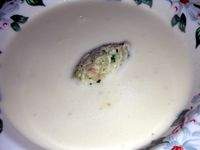By Lenn Thompson, Editor and Publisher
A couple of weeks ago, Nena and I had the pleasure of attending a wine dinner at Mirabelle Tavern, featuring the wines of Lenz Winery. It's always a pleasure to see Lenz's winemaker, Eric Fry and he was hustling his way around the dining room, talking with attendees about each of the wines as they were poured.
And, it's always great to sit down to a meal prepared by chef Guy Reuge, one of my favorite Long Island chefs.
 For me, the pairing of the night (and this was a night filled with well-considered pairings) was Lenz Winery's 2005 Old Vines Chardonnay with
For me, the pairing of the night (and this was a night filled with well-considered pairings) was Lenz Winery's 2005 Old Vines Chardonnay with
Guy's cream of roasted free-range chicken and almond soup with honey (pictured at right). It was a masterful pairing that brought two things that are rarely my first choice — cream soup and barrel-fermented chardonnay — together beautifully.
The other star of the night was the 2001 Estate Merlot, which is tasting great right now. Eric is lucky to be able to get some bottle age on his wines before release. He told me that he doesn't have much of this left, but he's very happy with the 2002 bottling as well.
I get invited to a lot of wine dinners — a lot of them. Without family nearby and only a couple reliable babysitters, actually being able to attend the dinners is rare. But, that doesn't keep me from reading over the menus and seeing what wines the wineries will be pouring.
A couple of the menus I've seen lately got me to wondering — how do the wineries see these events? Are they money makers or are they about showcasing your best for the public? I won't pretend to know the mechanics behind the dinners (how much money the winery gets, if any, for them etc.) but it seems that wineries are all over the place when it comes to what wines they choose. Some seem to really want to put their best foot forward, while others almost seem to be pouring off lesser wines that aren't selling elsewhere.
Take the Lenz dinner. No, Eric didn't pour his 2001 Old Vines Merlot ($55), but he was pouring his sparkling wine ($30) and was not pouring his 2004 cabernet sauvignon (which is underwhelming).
On the other hand, I recently saw a menu for a wine dinner that included a non-vintage red blend, an over-oaked chardonnay and totally ignored the winery's best wines.
Perhaps it's just the local wine lover in me, but I want wineries to pour their best (or at least their near-best if finances dictate) at these dinners. Sending out second-rate and second-label wines seems like a waste of time, unless your only goal is to make a little money and clean out some inventory.
I know that several winemakers and winery owners read this blog, so tell me, how do you approach wine dinners? What are your goals? How do you measure the success (or failure) of these events?
